Australo-Papuan Death Adders
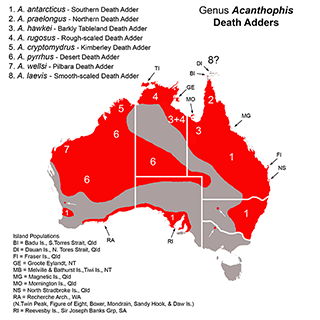
Distribution map of Death Adders

Although death adders are, like all front-fanged venomous snakes in Australia, members of the family Elapidae, their specialisation as ambush hunters has resulted in the evolution of a body shape resembling that of the “adders” of Europe, which are members of the Viperidae.
- Read more
This fascinating example of convergent evolution is responsible for these snakes, only distantly related to vipers, bearing the common name “adder”. Similarly, their ambush-hunting behaviour is responsible for the fact that, unlike the majority of Australian snakes; death adders often do not move away as humans (or other potential predators) approach, relying instead on their camouflage to keep them unnoticed and safe. According to a popular interpretation, this apparent obliviousness to approaching danger led people to refer to them as “deaf adders”, a name which mutated over time into their current moniker. The species composition of Acanthophis has been controversial among taxonomists and remains disputed, but most authorities recognise 8 species, 7 of which occur in Australia.
Distribution: Mainland Australia (excluding Victoria), New Guinea, eastern Indonesia.
Distinguishing characteristics: Body slender to stout, unicolour or with a patterning of crossbands, with smooth or keeled scales in 19-23 rows at midbody, head angular with elevated supraocular scales, 6-7 supralabials with temporolabial scale present, eyes small with vertically elliptical pupils, tail slender, extremely distinct from the body, terminating in a flattened spinous tip which may be black or yellow and contrasts with the dorsal body colouration.
Australian species: Acanthophis antarcticus. A. cryptamydros, A. hawkei, A. praelongus, A. pyrrhus, A. rugosus, A. wellsi.
International species: A. laevis Macleay, 1878 Papuan Smooth-scaled Death Adder which may yet be recorded on Torres Strait islands close to Papua New Guinea (see below).
Habitat: Adders occupy most habitats available across the range of the genus, from desert to rainforest. As ground-dwelling snakes that make use of various forms of natural ground cover (e.g. leaf litter; Triodia grass) they may be vulnerable to habitat degradation, particularly that caused by land clearance and grazing.
Activity: Typically nocturnal; a secretive sit-and-wait ambush hunter, which uses caudal luring to attract prey within strike range.
Diet: Death adders are generalists that feed upon small mammals, birds, lizards, and frogs. It is likely that allometric (size-related) shifts occur, with smaller specimens feeding more upon lizards and frogs and larger specimens including more mammals in their diets. Regional and interspecific differences in diet may also occur, although these are poorly documented.
Reproduction: Ovoviviparous, with litters of 8-30 neonates.
Venom: Death adder venoms are unusual amongst those of medically important Australian elapids in that they are predominantly neurotoxic, and significant effects on blood coagulation have not been documented (although the venom is weakly anticoagulant in vitro). It was long thought that death adder-induced neurotoxicity was exclusively mediated by post-synaptic neurotoxins, but more recent research has uncovered the presence of pre-synaptic neurotoxins in the venom of these snakes. Myotoxicity has also been documented following death adder envenomation and there is considerable variation amongst death adder venoms in their in vitro activities.
Seqirus (bioCSL) Death Adder Antivenom (DAV) is the recommended treatment for all death adder bites.
Acanthophis antarcticus (Shaw & Nodder, 1802)
Southern Death Adder
Distribution: ACT; NSW (east); Qld (south & east); SA (southern coastal); WA (southern coastal), with isolated or relict populations in southwestern WA and central NSW.
Islands: Magnetic, Fraser & N. Stradbroke Is, Qld; Revesby Is, SA; Recherche Is, WA.
Length: 400-700 mm, occasionally 1.0 m
Distinguishing characteristics: Body stout, dorsal scales smooth or weakly keeled in 22-23 rows at midbody; ventrals 125-139; cloacal plate entire; subcaudals 35-60; head scutes smooth or weakly rugose; six supralabials; temporolabial present.
Colouration & patterning: Dorsum brown or grey with irregular darker cross-bands, head similar to body, tail tip white, cream or yellow.
Habitat: Most habitats available across its range, from rainforest to scrubland and heathland.
Activity: Typically nocturnal a secretive sit-and-wait ambusher, which uses caudal luring to attract prey within strike range.
Diet: A generalist: primarily lizards in the southwest, lizards, small mammals, and birds in the southeast, possibly also frogs.
Reproduction: Ovoviviparous, with litters of 8-20, occasionally 30+ neonates.
Acanthophis cryptamydros Maddock, Ellis, Doughty, Smith & Wüster, 2015
Kimberley Death Adder
Distribution: WA (Kimberley).
Length: 400-645 mm
Distinguishing characteristics: Body moderately stout, dorsal scales keeled in 23 rows at midbody; ventrals 110-135; cloacal plate entire; subcaudals 46-56; head scutes strongly rugose; six supralabials; temporolabial present.
Colouration & patterning: Dorsum orange-brown with irregular darker cross-bands, head similar to body, tail tip black.
Habitat: Savannah woodland, Acacia woodland, and rocky grassland in the Kimberley region.
Activity: Typically nocturnal; a secretive sit-and-wait ambusher, which uses caudal luring to attract prey within strike range.
Diet: No records but presumed to be similar to other species of death adder, and thus comprise small mammals, birds, lizards, or frogs.
Reproduction: Ovoviviparous, with litters of up to 13 neonates.
Acanthophis hawkei Wells & Wellington, 1985
Barkly Tableland Death Adder
Distribution: NT (northeast); Qld (northwest).
Length: 500-700 mm, occasionally 1.3 m
Distinguishing characteristics: Body relatively stout, dorsal scales smooth or weakly keeled in 21-23 rows at midbody; ventrals 110-140; cloacal plate entire; subcaudals 35-60; head scutes moderately rugose; six supralabials; temporolabial present.
Colouration & patterning: Dorsum brown with irregular darker cross-bands, head similar to body, tail tip black.
Habitat: Black-soil plains and grassland on the Barkly Tableland.
Activity: Typically nocturnal; a secretive sit-and-wait ambusher, which uses caudal luring to attract prey within strike range.
Diet: No records but presumed to be similar to other species of death adder, and thus comprise small mammals, birds, lizards, or frogs.
Reproduction: Ovoviviparous, litter size unrecorded.
Acanthophis praelongus Ramsay, 1877
Northern Death Adder
Distribution: Qld (Cape York).
Islands: Badu Is, Torres Strait, Qld.
Length: 400-700 mm
Distinguishing characteristics: Body moderately stout, dorsal scales strongly keeled, in 21 rows at midbody; ventrals 110-135; cloacal plate entire; subcaudals 35-60; head scutes moderately or strongly rugose; six supralabials; temporolabial present.
Colouration & patterning: Dorsum brown or grey with irregular darker cross-bands, head may be darker dorsally, tail tip white or cream.
Habitat: Woodland, grassland and rocky grassland.
Activity: Typically nocturnal; a secretive sit-and-wait ambusher, which uses caudal luring to attract prey within strike range.
Diet: A generalist: lizards, small mammals, frogs, and occasionally birds.
Reproduction: Ovoviviparous, with litters of 14-17 neonates.
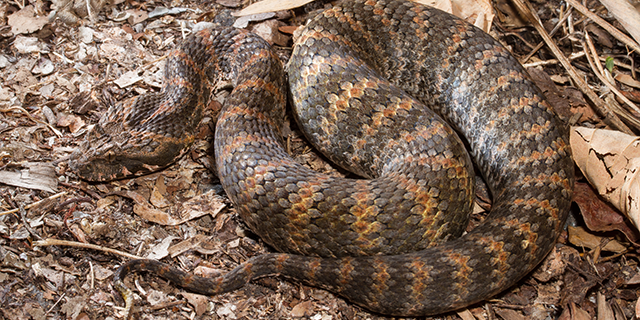
-
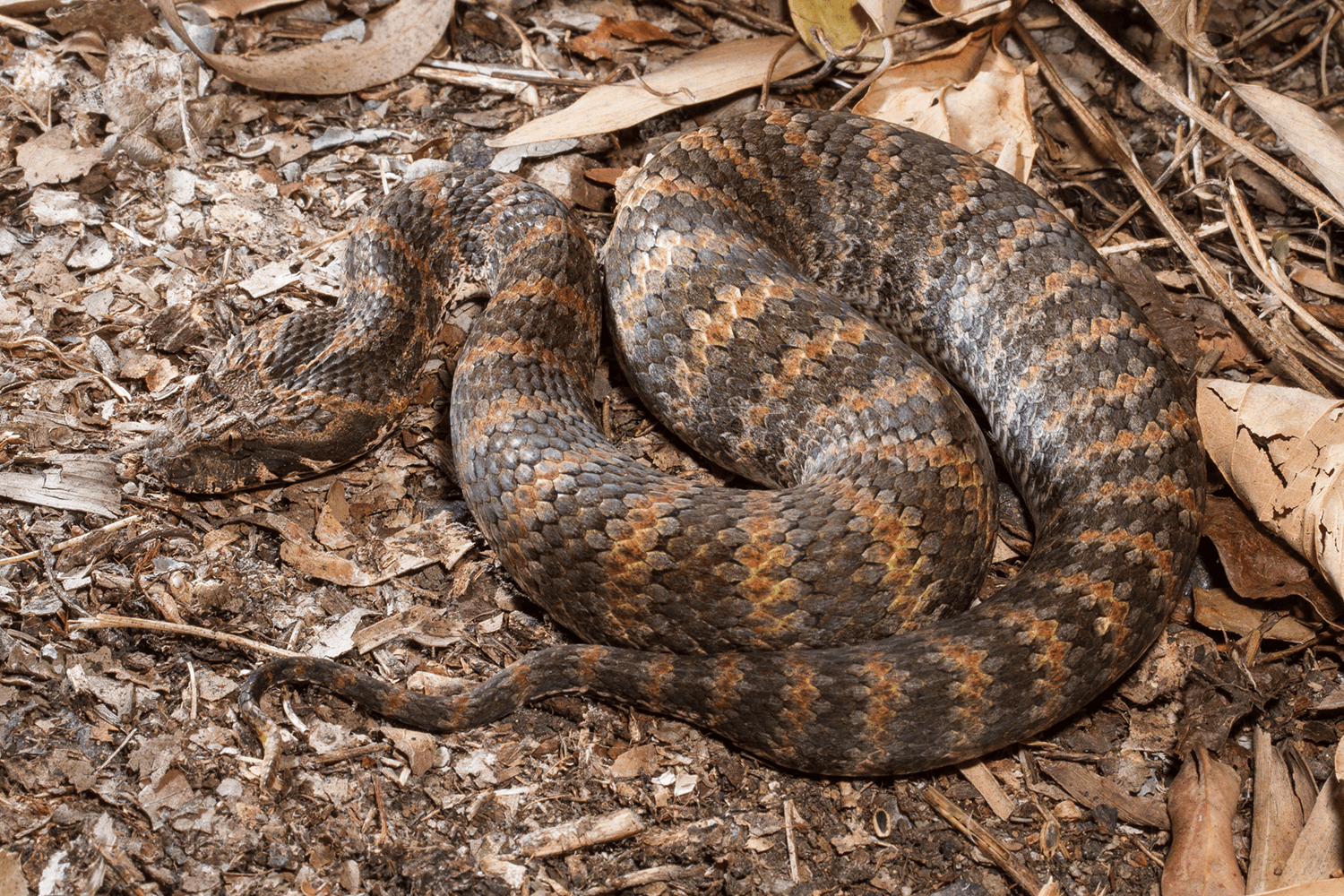
Acanthophis praelongus - Figure 1
Figure 1: Acanthophis praelongus, the Northern Death Adder -
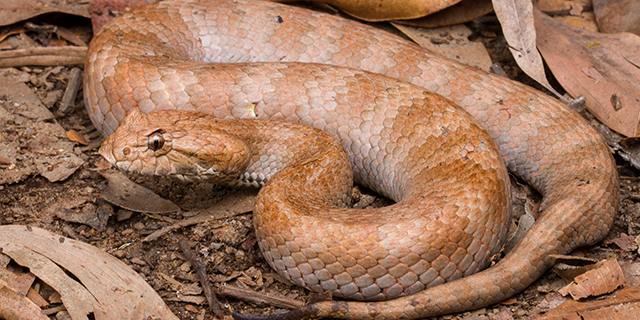
Acanthophis praelongus - Figure 2
Figure 3: Acanthophis praelongus, the Northern Death Adder: pale coloured form -

Acanthophis praelongus - Figure 3
Figure 2: Acanthophis praelongus, the Northern Death Adder: lighter coloured - close up
Acanthophis pyrrhus Boulenger, 1898
Desert Death Adder
Distribution: NT (south & east); Qld (southwest); SA (north); WA (west & central).
Length: 400-600 mm, occasionally 700 mm
Distinguishing characteristics: Body relatively slender, dorsal scales strongly keeled, in 19-23 (usually 21) rows at midbody; ventrals ventrals 120-160; cloacal plate entire; subcaudals 40-65; head scutes strongly rugose; six supralabials; temporolabial present.
Colouration & patterning: Dorsum red-brown with irregular brick-red cross-bands, head usually similar to body, tail tip yellow or black. Variation in colour.

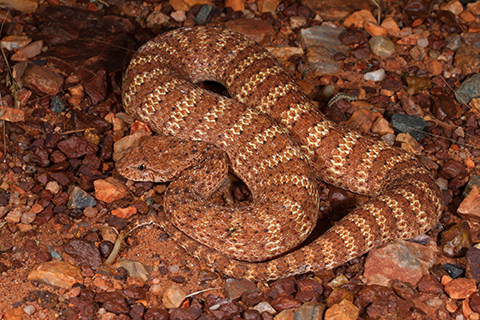
Habitat: Sandplains, deserts with spinifex grass, stony flats and Acacia woodland.
Activity: Typically nocturnal; a secretive sit-and-wait ambusher, which uses caudal luring to attract prey within strike range.
Diet: Primarily lizards, but occasionally small mammals and frogs.
Reproduction: Ovoviviparous, with litters of 11-13 neonates.
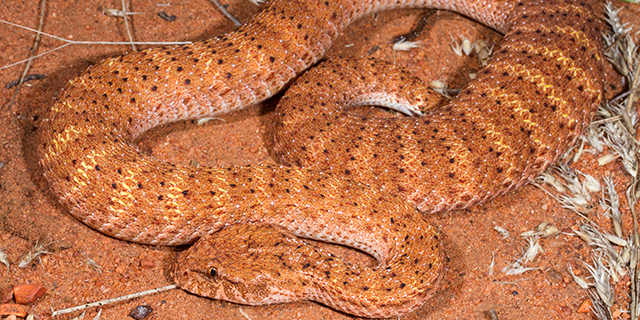
Acanthophis rugosus Loveridge, 1948
Papuan Rough-scaled Death Adder
Distribution: Qld (poss. northwest) NT (Top End); WA (poss. northeast).
Islands: Bathurst & Melville Is., NT, Groote Eylandt, NT, & Mornington Is., Qld,
Extralimital: South Fly region of New Guinea (Merauke, Papua Prov., WNG & Western Prov., PNG), also Tanimbar Is., Indonesia.
Length: 400-600 mm, occasionally 800 mm
Distinguishing characteristics: Scales strongly keeled, dorsal scales in 21-23 rows at midbody; ventrals 120-135; cloacal plate entire; subcaudals 35-60; head scutes moderately or strongly rugose; 6-7 supralabials; temporolabial present.
Colouration & patterning: Dorsum pale brown to grey with irregular dark brown cross-bands, head may be darker dorsally, tail tip white, cream or yellow. Colour variation.
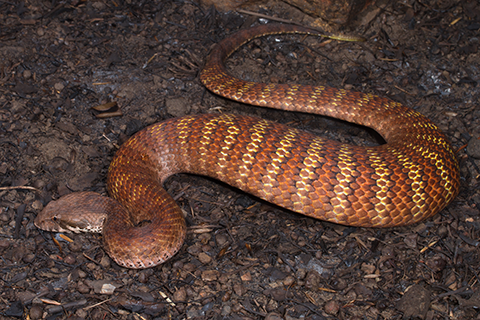
Habitat: Seasonally dry woodland, floodplains and stony ranges.
Activity: Typically nocturnal; a secretive sit-and-wait ambusher, which uses caudal luring to attract prey within strike range.
Diet: A generalist: lizards, frogs, and small mammals. Allometric (size related) shifts in diet have been documented for A. rugosus at Fogg Dam – smaller specimens feed primarily on lizards whilst larger specimens (particularly adult females) include more mammals in their diet.
Reproduction: Ovoviviparous, with litters of 11-12 neonates.
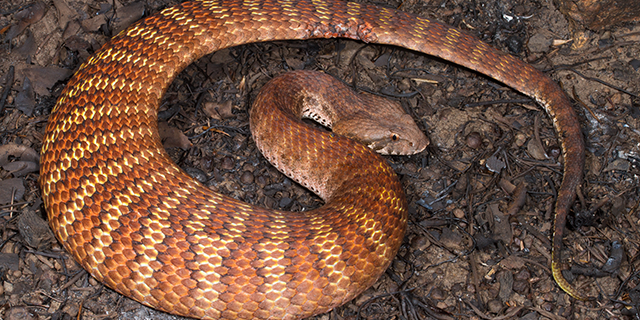
Acanthophis wellsi Hoser, 1998
Pilbara Death Adder
Distribution: WA (Pilbara).
Length: 300-500 mm, occasionally 520 mm
Distinguishing characteristics: Body relatively slender, dorsal scales strongly keeled in 19-21 rows at midbody; ventrals 120-145; cloacal plate entire; subcaudals 40-60; head scutes weakly rugose; six supralabials; temporolabial present.
Colouration & patterning: Dorsum dark red-brown with irregular pale orange cross-bands, head often darker dorsally, tail tip yellow or black.
Habitat: Sandplains, deserts with spinifex grass, stony desert and Acacia scrub in the Pilbara region.
Activity: Typically nocturnal; a secretive sit-and-wait ambusher, which uses caudal luring to attract prey within strike range.
Diet: A generalist: lizards, frogs, small mammals, occasionally birds.
Reproduction: Ovoviviparous, with litters of 11-13 neonates.
Occurring in New Guinea/eastern Indonesia, possibly present in Northern Torres Strait:

-
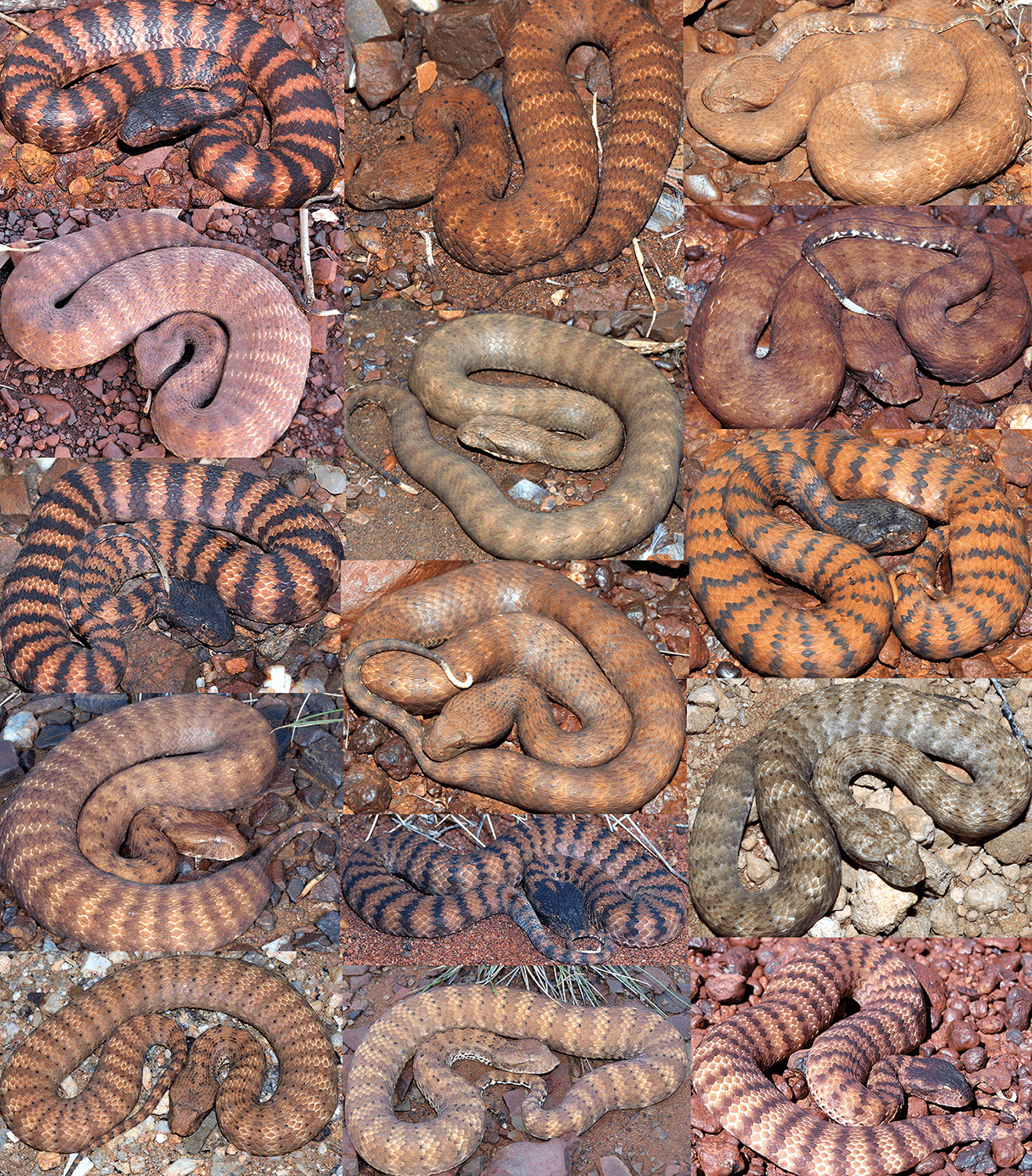
Acanthophis wellsi: Montage
Figure 4: Acanthophis wellsi - montage showing colour variation within this species in Western Australia (Photo - Brian Bush) -
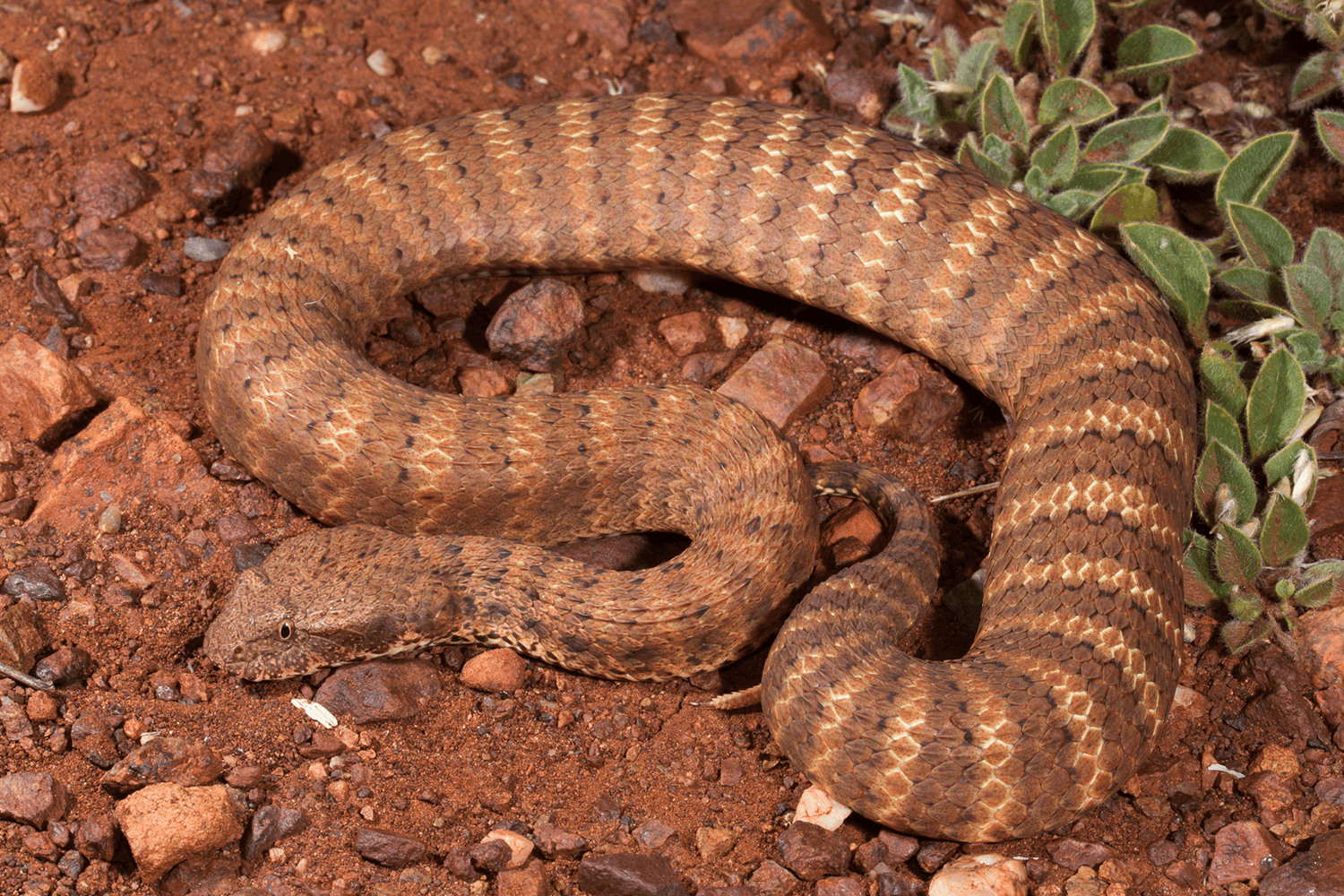
Acanthophis wellsi - Figure 1
Figure 1: an example of a lighter coloured Pilbara Death Adder (Photo - Stephen Zozaya) -
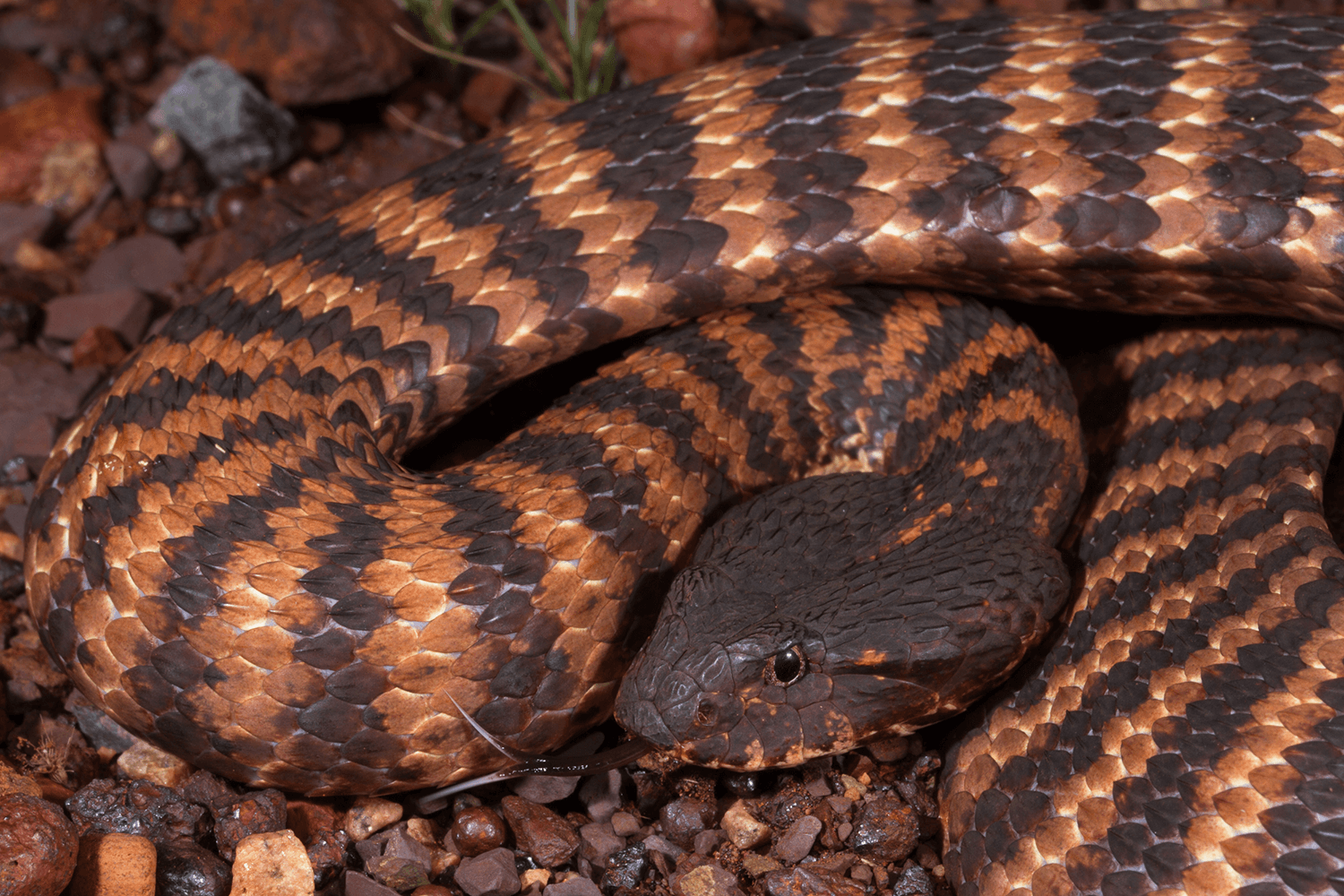
Acanthophis wellsi - Figure 2
(Photo - Stephen Zozaya) -
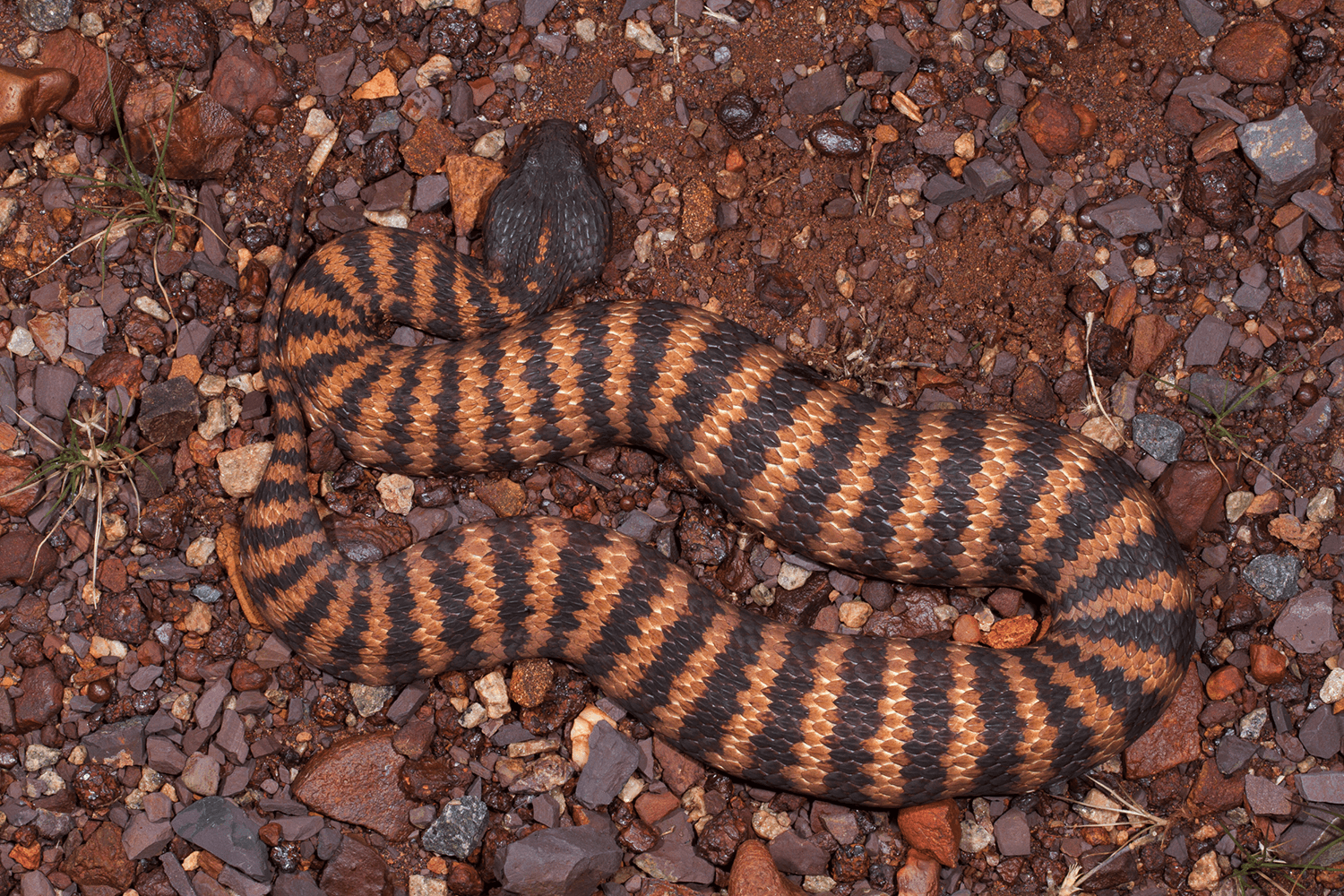
Acanthophis wellsi - Figure 3
(Photo - Stephen Zozaya)
Acanthophis laevis Macleay, 1877
Papuan Smooth-scaled Death Adder
Possible distribution: Dauan Is., Torres Strait, Qld.
Extralimital: Mainland New Guinea (Papua New Guinea and West Papua), and the Moluccas in eastern Indonesia.
Length: 490-590 mm.
Distinguishing characteristics: Body relatively stout, dorsal scales smooth in 21, occasionally 23, rows at midbody; ventrals 111-131; cloacal plate entire; subcaudals 41-53; head scutes smooth; six supralabials; temporolabial present.
Colouration & patterning: Dorsum highly variable, green, grey, red, orange, with irregular darker cross-bands, head similar to body, lips white with black bars, tail tip white to yellow.
Habitat: Savannah woodland, kunai grassland, rainforest, coffee and cocoa plantations, village gardens.
Activity: Typically nocturnal; a secretive sit-and-wait ambusher, which uses caudal luring to attract prey within strike range.
Diet: A generalist: small mammals, birds, lizards, and frogs.
Reproduction: Ovoviviparous, with litters of up to twenty neonates.